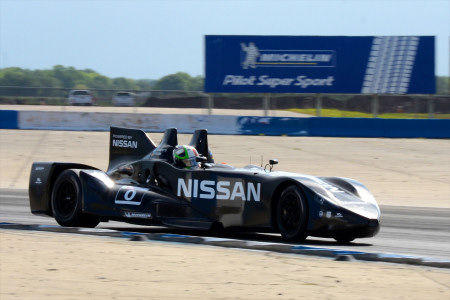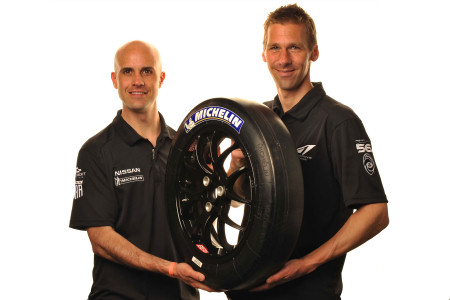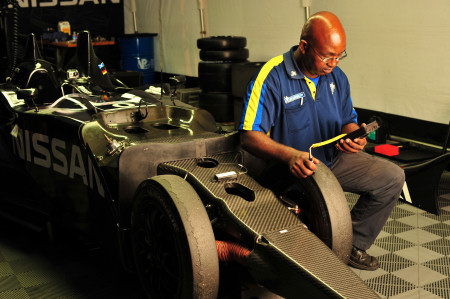The Way It Is/ Getting the Delta Wing on the roadby Gordon Kirby |
 Ben Bowlby and Duncan Dayton had to put in place two key components--tires and an engine--to make the Delta Wing come to life. An entirely new concept can strike fear into many hearts so a healthy dose of corporate courage was required to commit to the Delta Wing. Hats off therefore to Michelin and Nissan for stepping up to develop equally new concepts in tires and engines specifically for the Delta Wing.
Ben Bowlby and Duncan Dayton had to put in place two key components--tires and an engine--to make the Delta Wing come to life. An entirely new concept can strike fear into many hearts so a healthy dose of corporate courage was required to commit to the Delta Wing. Hats off therefore to Michelin and Nissan for stepping up to develop equally new concepts in tires and engines specifically for the Delta Wing.
During the last few years Michelin developed large front tires equal in size to the rears for the recent generation of LMP1 sports cars from Acura, Audi, Peugeot and Toyota. In 2009 Duncan Dayton's Highcroft team ran one of the ground-breaking Acura ARX-02a P1 cars that featured big front wheels and Michelin tires, but Michelin now is tackling a very different approach for the Delta Wing's tires. "For several years with the Acura LMP2 and P1 programs," Dayton remarked, "we were the lead tire development team for Michelin on the large format front tires that the Acura ARX-02a pioneered that is now in vogue and de rigueur in international sports car racing. We did the majority of the tire testing for Michelin on that program and developed a very good working relationship with the Michelin guys." In the fall of 2010 Michelin North America's motorsports manager Sylvia Mammone invited Dayton to attend the company's 'Motorsports on Main Street' event in Greenville, South Carolina, near its corporate headquarters. At dinner that evening Dayton sat next to Scott Clark head of Michelin Americas Small Tire Sales.  © Nissan DeltaWing Michelin is renowned for the quality of its tires and engineering and the company instantly recognized and accepted the Delta Wing's challenges. "There were only two tire companies that had the capability and resources to really get behind a project like this," Dayton observed, "Those companies are Michelin and Bridgestone/Firestone. Of course, Al Speyer at Bridgestone/Firestone was a big motivator for the Delta Wing in IndyCar but after the car was rejected by IndyCar it needed a tire supplier and when it comes to sports cars Michelin are the best. We wanted to work with them and when we made our presentation they were immediately excited about the prospect and loved the challenge technically. "When we got the nod from the ACO in June of last year to go to Le Mans this year we immediately started technical meetings with Michelin's engineers and they went to work. Michelin is one of the premier vehicle dynamics engineering groups in the world and they vetted the Delta Wing concept every way to Sunday. They weren't going to sign on if they weren't convinced that the project would be successful. "We unveiled Michelin's involvement at Petit Le Mans last fall and in my opinion that was the good house keeping seal of approval that gave serious credibility to the project even though there were still quite a few doubters and nay-sayers. But with that announcement we felt we had a strong wind in our sails and were headed in the right direction. We would have been in trouble without Michelin's involvement and incredible capabilities." Karl Koenigstein is Michelin North America's motorsports technical team leader and Delta Wing technical liaison. "We were aware of it as a potential new Indy car," Koenigstein said. "But after that went away we didn't hear too much about it until we were approached with the idea of developing tires for the car as a sports car. At that point we had some preliminary discussions with Ben Bowlby. He explained how the car was relevant to sustainable motorsports. He also explained the design concepts behind the car and why it should work dynamically and aerodynamically.  © Nissan DeltaWing "Then there was the technical challenge and the possibility to work in a region that was well outside the traditional motorsports envelope. We've been involved in rallying, motorcycle racing and sports cars for many years, but this was something that was outside the box and we were excited about the opportunity to learn new things." Koenigstein discussed developing the Delta Wing's tiny, four-inch front tires, the opposite of the move to bigger front tires Michelin developed for Acura, Audi and other P1 cars. "It was a very different way to skin the same cat," he observed. "That being the time you go around Le Mans in roughly three and a half minutes. We have worked with our manufacturer partners, Audi, Toyota and Acura (on the big front tires) and we feel we've accomplished that as well as we can to fit the rules. "Coming from beyond the traditional rules and traditional thinking the Delta Wing approaches it from a point of view of efficiency being the first goal and the lap times will come as opposed to going for lap time as the first goal and then trying to be as efficient as you can as you work to refine what you've got. So we felt that was an intriguing approach. "In terms of how to go about it, it really came down, like any motorsport project, to understanding the vehicle and what the vehicle is trying to do and designing a product that maximizes those characteristics. So the emphasis on the program has been to best understand what this car needs. "It required new tooling because we had never built that kind of size before," Koenigstein added. "We had been there before many years ago with the tires for the Deux Cheveau, but not in terms of motorsports." To produce the correct tires for the Delta Wing Michelin's engineers put a big effort into running a wide range of computer simulations. "It's really gratifying," Koenigstein said, "or maybe encouraging is a better word because the tires were really developed in the virtual world. We have a great deal of experience in sports car racing but we spent a fair amount of time with the Delta Wing doing computer simulations and making them as accurate as we could. A lot of work went into the simulations because when you're going this far out of the box some of your assumptions might be flawed.  © Nissan DeltaWing "We ran simulations not just to the basic Delta Wing design but to variations on that design. We wanted to see, A, what things had the biggest impact on the lap time and, B, to make sure we had a good, robust product that could take account for any potential error in our data or simulation methods. We wanted something that was robust rather than something that would break lap records and we're happy that the tires have worked well and been pretty darn close right out of the box." Initial testing has gone well from Michelin's point of view but Koenigstein stressed there's much to be done and learned. "It's gone very well from our standpoint but there's a lot of work and testing to be done," he emphasized. "We've learned a dramatic amount about how the tires work and how a car like this can operate. We're just now scratching the surface. We've got a long way to go yet. It's really hard to do good, long-run simulations and you can test all you want but there's nothing like the race to give you the real answers." Dayton added that he's been encouraged that every constituent who's been involved with the Delta Wing has reported positive computer simulations of the car's vehicle dynamics. "A lot of people from the FIA to the ACO to Michelin and Nissan and a few other OEMs have been doing various Delta Wing simulations and calculations," Dayton said. "But nobody came back to us and said it's not going to work. Everybody said all indications are that it will work." Yet Nissan was the only manufacturer who stepped up to commit to developing a 1.6 liter turbo four-cylinder direct injection 'Global Racing Engine' to power the Delta Wing. "For an OEM to step up and back a project like this without having the concept verified in actuality was a bold and courageous step," Dayton commented. "Some other OEMs had the opportunity to step up but didn't have the courage of their convictions to go ahead with this project. We're very much indebted to Nissan for helping us take the next step with the project. With an OEM like Nissan behind it gives considerably more weight and importance to the project." Dayton said Nissan test driver Erik Comas quickly became a convert to the Delta Wing gospel when he first drove the car in California early last month.  © Nissan DeltaWing "He immediately got totally infected with the car and just loves it. He was very curious and intrigued and likewise with Michael Krumm. In the little bit of time he spent in the car he was really excited about its potential." The Nissan engine has been developed by Ray Mallock's widely-experienced RML Group in Wellingborough, Northamptonshire. RML is in the heart of the UK's race engine-buulding industry and is located just north of Cosworth in the same town as Ilmor and Mercedes' race engine shops. Dayton's Highcroft operation will team with RML to run the Delta Wing through its test program and at Le Mans in June. "We needed a base of operations over there to help us run from afar," Dayton said. "Mallock is a great group and a competitor that we know well from observing the European scene and competing against them at Le Mans in 2010. I have great respect for those guys. They have the trucks and equipment and European plugs and all the stuff that we would have to source to take over there. So it seemed a prudent way to go forward. In 2010 with the Honda program we did a similar deal with ProDrive. They supplied European trucks and all the equipment you need to European spec." Over the next month or two the Delta Wing will run vigorously at a variety of smooth, fast European tracks, Monza included. "We've got plenty of testing and work doing the high-speed, long-distance testing we need to do on European tracks that are smoother tracks than you might find over here in America," Dayton said. "We'll also take the car to Michelin to show it and give a thank you to them. "We've got a lot of is to dot and tees to cross in a short amount of time. I made a wisecrack to somebody that the car's got half the weight, half the horsepower, half the aerodynamic drag, and half the fuel and tire consumption. So why should we be any different in having to do it in half the amount of time?" Koenigstein says Michelin is excited about the Delta Wing's wide appeal. "For sure it's created tremendous interest and I'm personally confident that the investment is a good one for Michelin," Koenigstein said. "A lot of people who have been around racing say it doesn't look like any racing car they've ever seen except maybe a Bonneville speed record car. But young people and kids who don't have any baggage think it looks fantastic. To them it looks racey and futuristic. The response to the car from young people has been really positive. They're really attracted to it." Concluded the wise-cracking Dayton: "In three years time everyone is going to start using the principles in this car, or it's going to be in either the Smithsonian or somebody's backyard as a flower planter." |
Auto Racing ~ Gordon Kirby Copyright 2012 ~ All Rights Reserved |
